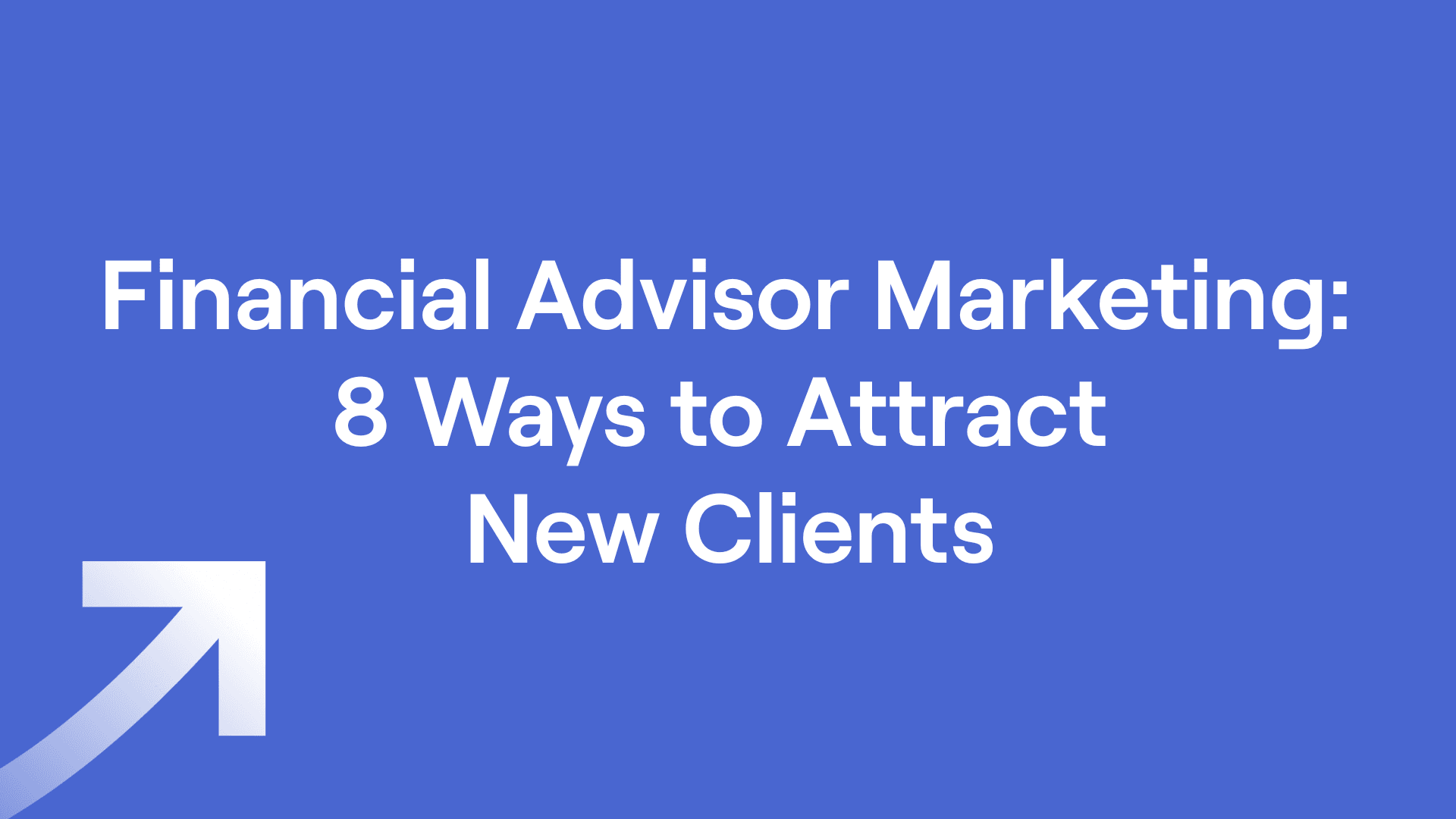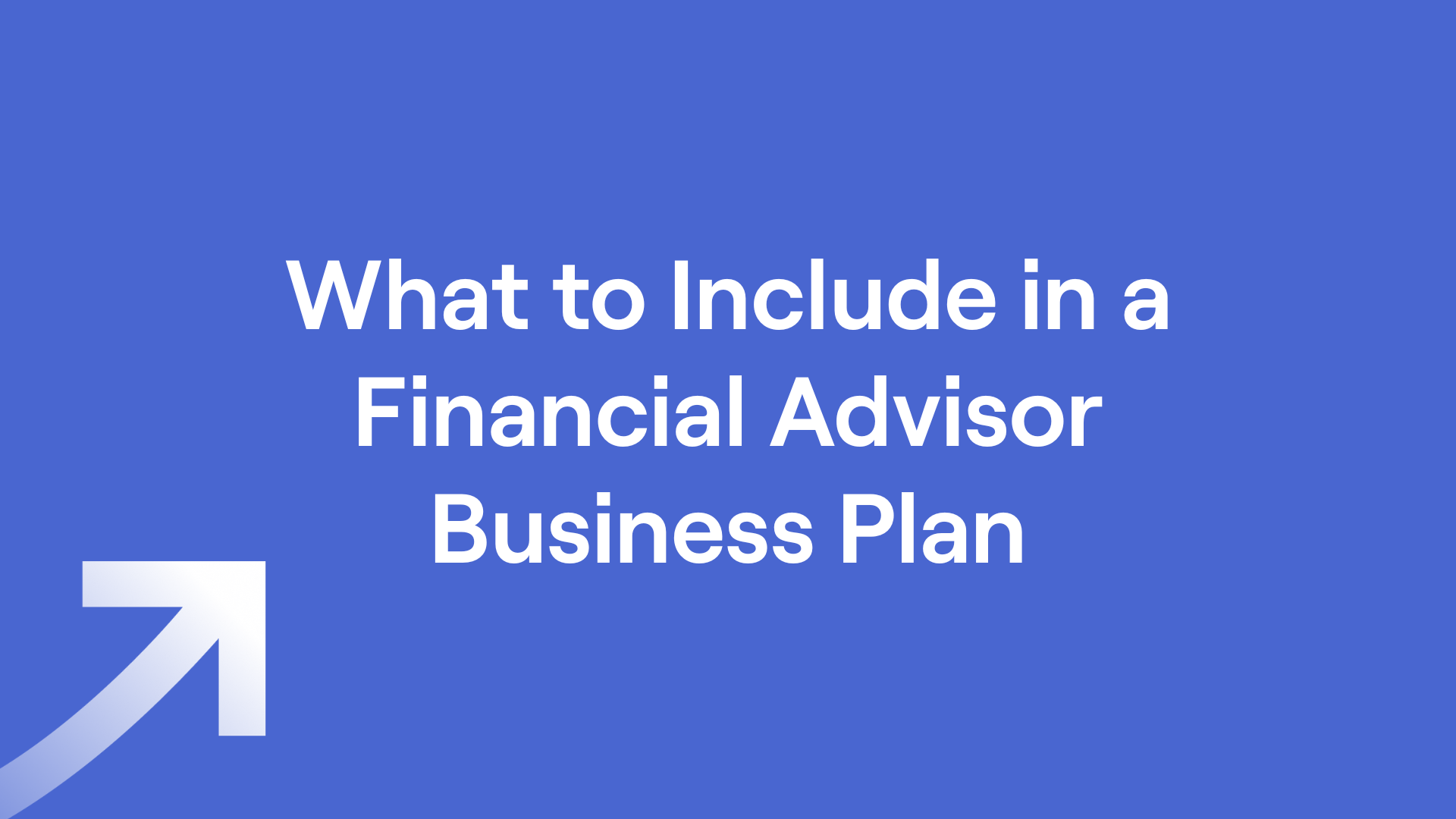Financial Advisor Marketing: 8 Ways to Attract New Clients
October 17, 2025

You’ve worked hard to earn your licenses, establish your processes, and choose your software, but how can you raise awareness and get your expertise in front of potential clients? You’re an advisor, not a marketer, but great financial advisors need great clients. This guide covers the marketing essentials: why a plan matters, how to build one, and eight proven marketing strategies to fill your pipeline and turn prospects into new clients.
Why you need a financial advisor marketing plan
A clear plan keeps you focused on the right prospects, messages, and channels so your time translates to pipeline. According to the 2024 Broadridge Financial Advisor Marketing Trends Report, “Advisors with a defined marketing approach generate 168% more leads each month and onboard 50% more clients every year.” No tactic or strategy listed below works alone, the key is to be consistent.
8 financial advisor marketing strategies to use in 2025
Where possible, connect each tactic to your ideal client profile (ICP) and niche. Several ideas below pair naturally with RightCapital features to deliver a personalized experience and ultimately win new clients.
1) Develop a client referral program
Financial advisors who responded to the Broadridge report found that client referrals convert twice as quickly as other prospects. According to The Kitces Report (Vol. 1, 2024), "How Financial Planners Actually Market Their Services", referrals are the most popular and one of the most effective marketing tactics.
Gaining referrals can be as simple as asking clients if they know anyone else who could use your financial services. It can also involve networking with local businesses, such as lawyers and accountants, as a “Center of Influence” (COI) who can help promote your services to their clients in need and vice versa. The Kitces Report states that 62% of advisors are involved in COIs.
A client appreciation event such as one where each guest brings a plus one may provide many opportunities to connect. While this can be a costly way to acquire new clients, the Kitces Report notes that this avenue brings in the highest median revenue for each new client.
2) Become known for educational content
Becoming a trusted voice means that new clients will choose you because they understand that you know your stuff. According to the Kitces Report, to gain recognition in the marketplace, 8% of advisors are writing a book, 17% are writing for third-party platforms, 11% are creating podcasts, and 8% are doing media appearances.
These days, more people are consuming video, specifically short-form video, such as Facebook or Instagram Reels, YouTube Shorts, or TikTok. Show up where they are already scrolling by producing your own short-form videos. We’ve previously written about tips and tricks on short-form video with N2 Content Marketing, including how to remain compliant.
N2’s Nick Meyer, the most followed CFP® on social media, explains it this way: “If you start posting short-form videos that show up in your prospective clients’ feeds, you could be 1 to 2 feet away from their face on the phone screen, multiple times a week…Who do you think is going to be the first person they turn to when they decide it’s time to work with a financial advisor? You’d rarely have to sell to clients anymore, because they already know, like, and trust you if they consume your social media content and find it valuable.”
Email marketing can be great for sharing specific content to various segments of leads or prospects. For example, share Social Security content with pre-retirees and debt management content with doctors fresh out of med school.
3) Optimize your online presence
Make sure that you exist on online advisor listing sites such as the Fee-Only Network and NAPFA. Kitces reported that these online advisor listings are the most efficient marketing tactic, with the lowest cost of acquisition at $646. It’s also a good idea to tighten up your Google Business listing with these tips.
Educational blog content is still an important and dependable way to help your website rank for SEO (search engine optimization) keywords. SEO is the process of optimizing your website and content to appear higher in Google search results, so that when potential clients search for terms like "financial advisor near me" or "retirement planning advice," they find you instead of someone else.
4) Host webinars or in-person seminars
Seminars came in with the second-highest average revenue per client, according to the Kitces Report. Invite potential clients to watch you walk through a case study of a typical household, focusing on a topic such as retirement, Social Security, or Medicare. Share your screen while working in your chosen financial planning software (so make sure to choose one that’s easy to present live) and showcase the impressive graphs, calculations, scenario comparisons, and collaboration tools. All of these factors can help you demonstrate your value. Answer questions as you present or have attendees schedule follow-up meetings during which they can input their own data for personalized planning recommendations.
5) Provide a personalized sneak preview of your capabilities
Some financial planning software platforms offer prospecting tools in which you can create a simple plan with limited input to prove your value from day one. With RightExpress by RightCapital, for example, gather data from a potential client in just a few steps to show them a topic-specific financial plan that addresses their biggest planning concern. Share insights on retirement, Social Security, risk, or debt and utilize Tasks and Vault, then convert what you’ve already created into a full plan when the prospect becomes a client.
6) Grant access to an advisor-branded client portal and mobile app
Impress your prospects and differentiate your financial services from others with professional-looking software and a client-facing mobile app that you can “white-label” with your logo, your colors, and your settings. Build trust and brand recognition by customizing your financial planning software, for example, to mirror your website and social media graphics. Increase engagement with prospects and clients, enabling them to log into the plan to review progress, complete tasks, and collaborate with you every step of the way.
7) Share social proof from current clients
If your state has adopted the SEC new marketing rule and it’s permitted by your firm, you can ask past or current clients for testimonials, as long as you follow a few specifics and properly disclose the details. Learn more about following the SEC new marketing rule for testimonials.
8) Engage with ideal clients on social media
Social media marketing typically plays more of a supporting role for advisors. Expand your outreach, continue building your brand, and prove your expertise to potential clients through educational content. The Kitces Report notes, “Advisors that won clients through social media are focusing much of their messaging on LinkedIn,” with 94% of advisors posting on LinkedIn vs. 74% on Facebook, the next highest network found in the study.
What to include in a marketing plan for your financial advisor firm
A thoughtful marketing plan turns good intentions into predictable growth. Start by clarifying your ideal client profile, set a few SMART goals, and choose one or two strategies you can execute consistently. Track metrics such as customer acquisition cost, conversion rates, and time it takes to convert a prospect so you know what’s working and where to refine. If you use RightCapital’s lead generation URLs, you will be able to distinguish and analyze what’s different between prospects coming to you via a form on your website versus your monthly email newsletter, for example.
How much can you expect to spend on your marketing efforts?
How much you spend on marketing can vary widely depending on which channels you use, the size of your firm, markets where you operate, and more. Some marketing tactics cost more in dollars, and others more in your time. It comes down to what activities will reach your target audience. As noted in the Kitces Report, the most expensive tactics per client are typically events (such as customer appreciation events, seminars, and webinars) and the least expensive are lead generation platforms (such as online advisor listings and third-party review sites).
Broadridge’s research found that the mean average is $15,908 a year but the median is lower at $6,250. Teams are spending an average of $23,222 and the average solo advisor is spending just under $9,000 a year.
Conclusion
Building a successful advisory practice requires more than financial expertise; it demands a strategic approach to marketing. You don’t need to be a marketing guru or implement all eight strategies at once. Instead, start with a clear plan, focus on one or two tactics that align with your ideal client, and execute them with consistency. As you build momentum, the right technology will not only streamline your efforts but also elevate the client experience, turning prospects into lasting relationships.
Discover how to showcase your value more effectively with interactive planning tools by scheduling your free RightCapital demo today.





